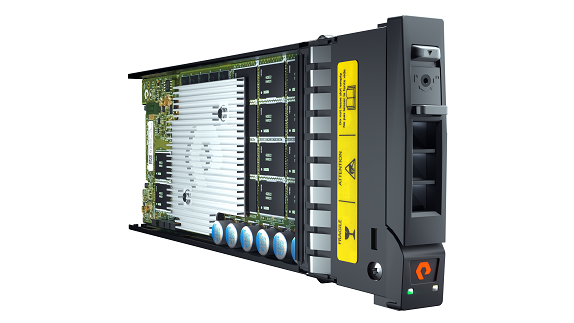Pure Storage Unveils New QLC Module, Plans Low-cost 5.2-PB In 6U Flash Array
“We‘re not just going cheap and deep. We don’t want a lot of gimmicks to deliver QLC, such as the use of storage-class memory as a cache. We get rid of the gimmicks to deliver both performance and capacity. Every DirectFlash module has DRAM to support performance, but the entire array has bit-level access to QLC,” says Scott Baker, vice president of product marketing for Pure Storage’s Flash Array product line.

All-flash storage technology developer Pure Storage on Tuesday unveiled new higher-capacity versions of its QLC DirectFlash modules the company claims will allow it to offer low-cost all-flash storage arrays for enterprise workloads with up to 5.2 petabytes in a 6U form factor.
QLC is a consumer-grade of flash storage that allows the building of storage arrays and SSDs which offer relatively high performance at a significant cost advantage compared to other types of flash technology. However, its use in enterprise storage has been limited because of relatively high latency and faster rates of flash memory cell degradation.
Mountain View, Calif.-based Pure Storage last Fall addressed the need for lower-cost flash storage with the introduction of its FlashArray//C, its first QLC-based all-flash storage array and still one of the few in the market.
[Related: The 10 Hottest SSD And Flash Storage Products Of 2020 (So Far)]
FlashArray//C is targeted at a wide range of applications traditionally done by hard drive-based arrays including disaster recovery, test/dev, and some primary storage. Rather than standard QLC-based SSDs, the arrays use Pure Storage‘s proprietary NVMe-based DirectFlash modules which were designed to communicate directly with the QLC NAND memory to extend the life of the flash for enterprise environments.
Pure Storage Tuesday unveiled two new DirectFlash modules, one with capacity of 24.7 TBs, and the other with 49 TBs, making them among the highest-capacity QLC devices in the market, said Scott Baker, vice president of product marketing for the company‘s Flash Array product line.
With the new modules, Pure Storage can offer QLC-based arrays which scale from 366 TBs raw capacity or 1.3 petabytes of logical capacity in 3U to up to 1.4 petabytes of raw capacity or 5.2 petabytes of logical capacity in 9U, Baker told CRN.
“By the end of the year, we will be showing 5.2 petabytes in 6U,” he said.
The expansion of Pure Storage‘s DirectFlash module line is not only aimed at moving the storage market from either the hard-drive-based or the hybrid flash and hard drive storage market, neither of which Pure addresses, but at consolidating new workloads to lower-cost flash storage without the need for work arounds to the technology, Baker said.
“We‘re not just going cheap and deep,” he said. ”We don’t want a lot of gimmicks to deliver QLC, such as the use of storage-class memory as a cache. We get rid of the gimmicks to deliver both performance and capacity. Every DirectFlash module has DRAM to support performance, but the entire array has bit-level access to QLC.”
While there are industry concerns about the longevity and latency of QLC flash storage, Pure Storage has always done a good job at the software and firmware levels to integrate it into their arrays, said Ryan Sheehan, vice president of advanced solutions at SHI International, a Somerset, N.J.-based solution provider and Pure Storage channel partner.
“Pure Storage doesn‘t focus on traditional tiering,” Sheehan told CRN. ”But its ability to use the profile of the data to move it to the right type of storage is important. With higher-capacity arrays based on its QLC DirectFlash modules, the all-flash storage story is complete, and going forward there will be no more need for spinning disk.”
The high cost of flash-based storage technology has allowed spinning disk to remain in the market, Sheehan said.
“Customers love the performance promise of flash, but is it worth the extra cost?” he said. ”As the cost of flash gets closer to that of disk, and customers get guarantees of performance, they will pay the extra cost. And Pure promises to provide more than just cheap storage.”
Sheehan said he has not seen any other vendors do as much to develop enterprise-class QLC-based storage arrays as Pure Storage has, although he said it is likely on the roadmaps of the vendor‘s competitors.
“This opens a lot of creativity for customers those use cases didn‘t make sense for flash before,” he said. ”This opens a new way to architect solutions to solve customers’ enterprise storage problems.”
Pure Storage‘s FlashArray//C line have been targeting data protection and data repository use cases, but customers are looking at how to use it for workload consolidation, Baker said.
“Customers may now be able to run two or three different workloads, or put in place a hub-and-spoke environment by moving backup data between arrays with our partner [Barr, Switzerland-based] Veeam,” he said. ”We are also starting to see it used in more container-based workloads and test-dev environments thanks to our partnership with [Waltham, Mass.-based] Actifio.”